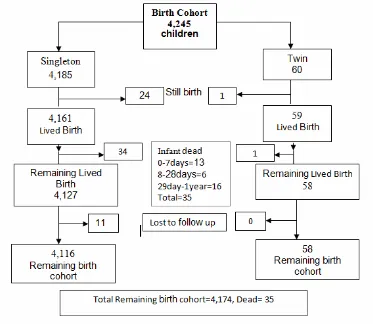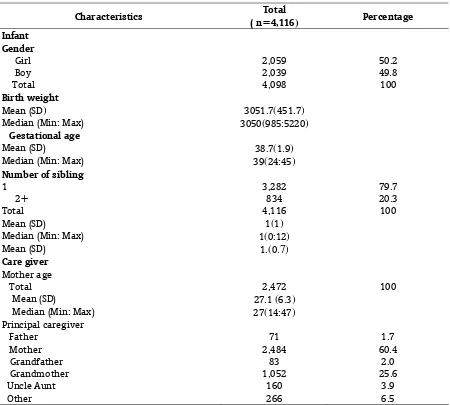CHILD REARING PRACTICES FOR CHILDREN AT THEIR FIRST YEAR OF LIFE:
FINDINGS FROM THE PROSPECTIVE COHORT STUDY OF THAI CHILDREN
Sukanya Kansin1, Aroonsri Mongkolchati2, Bandit Thinkhamrop3 Faculty of Nursing, Ratchathani University,Udonthani, Thailand1
ASEAN, Institute for Health Development, Mahidol University,Nakornprathom, Thailand2 Department of Biostatistics and Demography, Faculty of Public Health,
KhonKaen University, Thailand3 email : [email protected]
Abstract
Window period of child growth and development was 1-2 years of age where appropriate child rearing plays a major role. Most studies investigated the rearing styles while information for the specific practices of the rearing was limited. This study aims to describe specific child rearing practices in Thai children.
This study is part of the Prospective Cohort Study in Thailand Children (PCTC) conducted in 2005.The PCTC enrolled 4,245 children who were born between October 15, 2000 and September 14, 2002.The total samples were 4,116 in four community-based rural areas including Northern region, Northeastern region, Central region, Southern region, and one tertiary hospital in Bangkok. Data were collected via face-to-face interviews. Child rearing information was obtained by both observation and interviewing.
4,116 children aged of 12 months ± 1 week, 79.7% had one sibling, 50.2% were girls, with a mean mother age of 27.1±6.3 years, gestational age of 38.7±1.9 weeks, and birth weight of 3,051.7±451.7 grams. More than half, 62.1%, of the principal caregivers were parents, 27.6%were grandparents and 10.4%were others. Child rearing practices were vary across different dimensions. In the responsiveness dimension, warmed were given to almost all the children 96.6%, decreasing to attachment 56.6 %, very low in cohesion 0.7% and clear communication 0.7%. In demandingness dimension there were 39.9 % on confrontation, monitoring 5.7 % and consistent 1.2 %.
This study showed that all except warmed and attachment child rearing practices were critical inadequately given to the first year of age with needs and urgent appropriate responses.
Keywords: Child rearing practices, Thai children, First year of life, growth and development, Cohort study.
A. Introduction
Children are an important human resource(
1-2), window period of their growth and
development was 1-2 years of age where appropriate child rearing plays a major role. This period has long been known as a strong predictor of child growth and development. Several studies reported that child rearing practices (3-5) affected to Children's development.
A review literature related to child rearing practices base on the Baumrind’s. concept Which has developed a model using two
dimensions there were Responsiveness and Demandingness(6-12).
,Includes helping children to relieve anxiety the effects of isolation.
For Demandingness consist of 3 items there are the care giver’s practices for Controls children by; The first Monitoring are use reinforcement, punishment, feed back, extinction or negative reinforcement, modeling behavior, Instruction, reasons and reasoning and training. The second Confrontation are negotiation, demanding and the last consistent, contingent are caregivers must be consistent and flexible, be the disciplinary rules, adherence to teach things and continuity and consistent emotional.
Most studies investigated the child rearing styles(13-16), while information for the specific practices of the rearing was limited. This research aims to describe specific child rearing practices in Thai children.
B. Method
This study is part of the Prospective Cohort Study in Thailand Children (PCTC) conducted in
2005.The PCTC enrolled 4,245 children from four community-based rural areas including Northern region, Northeastern region, Central region, Southern region, and one tertiary hospital in Bangkok. The infants born between October 15, 2000 and September 14, 2002 were enrolled.. Our component of the study involved 4,116 children who’s reached 12 months ± 1 week and excluded twin.(Figure1). Protection of human subjects. The PCTC project was approved by the Nation Ethics Committee of the Ministry of Public Health on 22 September 2000.
Study outcome
Primary outcome is child rearing practices in Thai children. Data were collected via face-to-face interviews. Child rearing information was obtained by both observation and interviewing.
Statistical analysis
Describe each demographic characteristic was presented as a mean and a standard
deviation (SD) for continuous variables and as a frequency and percentage for the categorical variables. The various child rearing practices by using frequency and percentage.
Strength of the study
The strengths of the study include: the wealth of prospective, longitudinal, epidemiological collected from observational, community-based. It is the evidence that was based on the largest cohort study of Thai children. It can be viewed as the first project of evidence for Thai children in this area and this study deep investigated to child rearing practice.
C. Result and discussion
4,116 children aged of 12 months ± 1 week,
79.7% had one sibling, 50.2% were girls, with a mean mother age of 27.1±6.3 years, gestational age of 38.7±1.9 weeks, and birth weight of 3,051.7±451.7 grams. More than half, 62.1%, of the principal caregivers were parents, 27.6% were grandparents and 10.4% were others.(Table1.) The first year of ageis sensitive period or window of opportunity(17). Infant cannot control themselves , must rely on parents or care giver. It was during this time that parents are raising the most, followed by the grandparents. Maybe because Thai society changed to modernization, family structure changes. Children had migrant parent(s) to work in the industrialized or urban areas transferred child rearing to others include a grandparents and several left their children with grandparents
Table 1. Demographic characteristics presented as percentage unless specified otherwise
Characteristics Total
( n=4,116) Percentage
Number of sibling
alone (18).
Child rearing practices in over all were vary across different dimensions. In the responsiveness dimension, warmed were given to almost all the children, decreasing to attachment, very low in cohesion and clear communication. In demandingness dimension there were rear very low all of items.
Diagram1
Child rearing practices classified in each region found that in warmth, Cohesion, Clear
communication, monitoring and consistent not different. But in attachment and confrontation, there were difference between area. It is because Thailand has a variety of different cultures, the different parenting, especially in southern as the devout in religion and civil unrest have occurred in the area, so that was comforting is at a higher level Supervisory control and relatively high as well. And Supervisory Control Quite the same high.
Diagram 1.
This study showed that Thai children were reared mainly with warmth but very rare with cohesion and clear communication.
Probably because the family originally Thailand's extended family, which has a kinship ties and thus raised warmth, love and acceptance.(19) A show of warmth similar to
European countries. The Western beliefs of
parental responsiveness include explicit displays of affection, such as hugging, kissing, or praising
(20). But differs from Chinese. Which Chinese parents may believe that praising their child could deter the child's achievement (21).
Parents' control and responsive may have different meanings in different cultures, especially in cultures that place value on relatedness and interdependency and discourage the expression of overt emotions. In Confucian based cultures, parental demonstrations of authority, such as the use of firm directives, close monitoring, and the use of "shaming" as a socialization tool may be perceived more favorably than in other cultures (22)
However, in Thailand ,the care giver should care closely, advice their children. and urgent appropriate responses.
D. Conclusions:
This study showed that all except warmed and attachment childrearing practices were critical inadequately given to the first year of age with needs and urgent appropriate responses.
Acknowledgements:
The authors express their heartfelt gratitude to the families who participated in PCTC. The research was supported by the Thailand Research Fund, the Health System Research Institute, the Ministry of Public Health and the World Health Organization. We gratefully acknowledge the Faculty of Nursing,
Ratchathani University,Udonthani for their
financial support of this study.
E. References
1. Luong QV.(2011), How Can Child Labor Lead to an Increase in Human Capital of Child
2. Laborers and What Are Policy Implications? [Internet] [Ph.D.]. [United States -- California]: University of California, Berkeley; [cited 2013 Jul 7]. Available from: http://search.proquest.com/docview/9284499 62/abstract/13F1F0FECEA44FB4053/13?accou ntid=27797
3. Bustelo M.(2011), Three essays on
investments in children’s human capital [Internet]
4. [Ph.D.]. [United States -- Illinois]: University of Illinois at Urbana-Champaign; [cited 2013
Jul 7]. Available from: http://search.proquest.com/docview/1009735
727/abstract/13F1F0FECEA44FB4053/19?acco untid=27797
5. Murray A, Egan SM.(2014), Does reading to infants benefit their cognitive development at 9-months-old? An investigation using a large birth cohort survey. Child Lang Teach Ther,30(3):303–315.
6. Thepsuthammarat K, Thinkhamrop B,
Choprapawon C.(2012), Association
between types of play materials and cognitive development among 12- month-old Thai infants: the prospective cohort study of Thai children. Asian Biomed, 6(5):703–711.
7. Baumrind, D. (1967) Child care practices anteceding three patterns of preschool 8. behavior. Genetic Psychology Monographs. 9. Baumrind,D. (1911), The influence of
parenting style on adolescent competence and substance use. J Early Adolesc,11(1); 56-95.
10. Baumrind,D.(1967). Child care practices
anteceding three patterns of preschool behavior. Genetic Psychology Monographs, 75, 43-88.
11. Baumrind,D.(1991). The influence of
parenting style on adolescent competence and
12. substance use. Journal of Early
Adolescence, 11(1), 56-95.
13. Baumrind,D.(1996).The discipline
controversy revisited. Family Relations, 45, 405-
15. Kail,R.V.(2001).Children and their development. 2nd ed. New York: Prentice Hall.
16. McWayne, C.M., Owsianik, M.,Green, L.E., & Fantuzzo, J.W. (2008). Parenting
17. behaviors and preschool children’s
social and emotional skills : A question of the
18. consequential validity of traditional
parenting constructs for low-income African
19. Americans. Early Childhood Research
Quartery, 23, 173-192.
20. Balaguru S. Acculturation and its impact on child rearing and child behavioral problems: 21. A study of Asian-Indian immigrant families
[Internet] [Ph.D.]. [United States –Virginia]: 22. University of Virginia; 2004 [cited 2013 Jul 5].
Available
23. from:http://search.proquest.com/docview/30 5106744/abstract/13F12A11F52A428C44/1?ac countid=27797
24. Velasco CT. A study of the attitudes, beliefs, and self-reported practices of Mexican 25. immigrant mothers about child rearing
[Internet] [M.S.W.]. [United States California]: 26. California State University, Long Beach; 2008
[cited 2013 Jun 18]. Available from:
27. http://search.proquest.com/docview/3048405 76/abstract/13EBAFD15AD2965FE9D/5?accou ntid=27797
28. Sands RG, Goldberg-Glen RS. Factors
associated with stress among grandparents 29. raising their grandchildren. Fam Relations.
2000 Jan;49(1):97–105.
30. Chen X, Liu M, Li D.(2000) Parental warmth, control, and indulgence and their relations
31. to adjustment in Chinese children: a
longitudinal study. J Fam Psychol JF J Div Fam
32. Psychol Am Psychol Assoc Div 43. 14(3):401– 19.
33. Murray GK, Jones PB, Kuh D, Richards
M.(2007) Infant developmental milestones and
34. subsequent cognitive function.Ann
Neurol;62:128-36.
35. Nanthamongkolchai S, Munsawaengsub C,
Nanthamongkolchai C.(2009) Influence of
36. child rearing by grandparent on the
development of children aged six to twelve years. J
37. Med Assoc Thail Chotmaihet
Thangphaet;92(3):430–4
38. Manut Vanichanon.(2003), Thailand warmth of family-Lasting happiness. J Economic 39. and social;January-Murch,29.
40. Mimi Kar Wing Wong.(2011),Parental Teaching, Warmth, and Control as Predictors of
41. Child Social Competence in Immigrant
Chinese Families,California School of
42. Professional Psychology - San Francisco
Campus in partial fulfillment of requirements for the degree of Doctor of Philosophy.
43. Wolf, M. (1978). Child training and the
Chinese family. In, Family and kinship in Chinese society (pp. 37-62). CA: Stanford University Press.
44. Fung, H. (1999). Becoming a moral child: The socialization of shame among young

